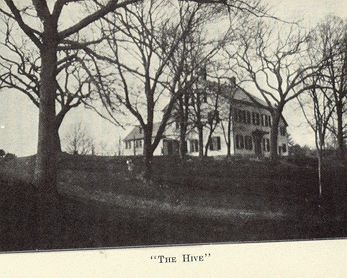The picture above is from the House of the Seven Gables, a museum in Salem, MA. The House of the Seven Gables is one of Nathaniel Hawthorne's novels.
Annotated Bibliography – Due May 12, 2010
In this assignment, you will be writing a five to ten item annotated bibliography that includes both primary and secondary sources on a specific topic. Among these sources may be the literary works we’ve read, the films we’ve seen, or one or more of the web sites I’ve posted here on my blog at Multiply. Feel free to include a source from a library database or a scholarly journal on-line or a picture or a film.
If you’re not familiar with the annotated bibliography, it is not an argumentative, research paper but an informative, expanded version of the works cited page. Begin the annotated bibliography with a one-page overview of your topic. The overview will also include an outline of your research process beginning with your finding a topic and then narrowing it. Each source is then listed alphabetically, following MLA format; after each single source, you will be summarizing, evaluating, and analyzing it, explaining how it is relevant to your topic. Strive for two to four paragraphs of summary/analysis per source. Check the highlighted entry on sample annotated bibliographies at my blog. I have also posted sample annotated bibliographies on a variety of topics at WebCT.
Choose a topic that is related to your earlier papers, your presentation, or the midterm. If you are expanding your first paper on Frederick Douglass’ slave narrative, you may want to go back to see if other individuals wrote slave narratives. You might also want to look at what others have said about Douglass and his work. Or you may want to choose a topic from the second half of the semester. You may even want to choose a topic that is more about American culture or a film set during our time period. Did you know that Kevin Willmott made a film imagining what the United States would have been like if the South had won the Civil War?
As you look for sources, consider the ways that research can augment and even challenge your own thinking about a work. Use all of the library research techniques you’ve learned in high school and from your composition class—searching Web Voyage and library databases as well as Google, using note cards or other means for taking notes and avoiding plagiarism, summarizing and paraphrasing sources as well as quoting them, using quotation marks to indicate quotes, and, of course, using MLA appropriately. Citation is an open-book quiz. I do not expect you to have memorized MLA, but I do expect you to use a handbook to check your citation.
I encourage you to meet with a college librarian, a Writing Center tutor, or me if you are not sure how to approach this project or if you have not done this type of assignment before. Plagiarism involves copying another person’s writing or reading a book review or abstract and then writing a bibliographic entry on the original source. Consulting with a librarian on research strategies is not plagiarism.
Grading
An A project will be outstanding on all or most levels: choice of topic and sources; focus of topic; close, critical reading of texts; summary; relevance of evaluation; analysis; and grammar/mechanics (including MLA). (I have listed each level in order of importance; however, errors in the last area will affect your grade.) It may be on a topic we have been emphasizing all semester. In that case, it will show me new insights derived from your close, critical reading of primary and secondary sources. Alternately, this paper may be on a reading that has been assigned but not discussed in class. This option may not produce an easier “A,” as I will be looking at your ability to research a topic without the opportunity to discuss it in class.
A B project will be effective on all or most levels: choice of topic and sources; focus of topic; close, critical reading of texts; summary; relevance of evaluation; analysis; and grammar/mechanics (including MLA). (I have listed each level in order of importance; however, errors in the last area will affect your grade.) It may be on a topic we’ve discussed in class or a reading that I’ve assigned but not discussed in class.
A C project will be adequate on all or most levels: choice of topic and sources; focus of topic; close, critical reading of texts; summary; relevance of evaluation; analysis; and grammar/mechanics (including MLA). (I have listed each level in order of importance; however, errors in the last area will affect your grade.) It may be on a topic we’ve discussed in class or a reading that I’ve assigned but not discussed in class. Note that a C is not failing, simply “average.”
A D project will contain significant problems on one or more levels: choice of topic and sources; focus of topic; number of sources; close, critical reading of texts; summary; relevance of evaluation; analysis; and grammar/mechanics (including MLA).
A failing (F) project will be inadequate on one or more levels: choice of topic and sources; focus of topic; number of sources; close, critical reading of texts; summary; relevance of evaluation; analysis; and grammar/mechanics (including MLA).
Below is a picture of one of Brook Farm's main buildings, The Hive. I'm guessing that this picture is from the early 20th century. For more information about Brook Farm, see this site:
http://www25.uua.org/uuhs/duub/articles/brookfarm.html


No comments:
Post a Comment